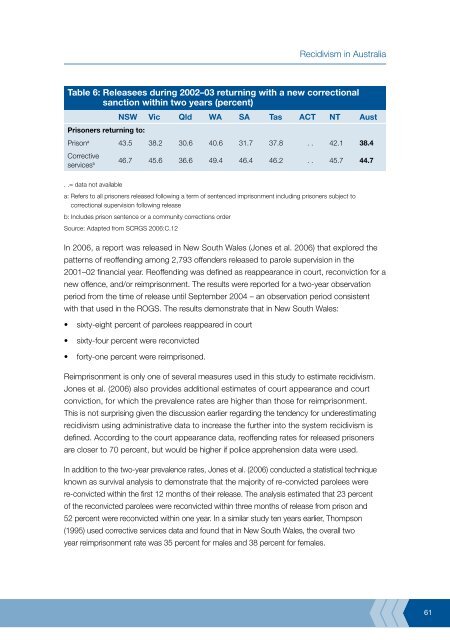Recidivism in Australia : findings and future research - Australian ...
Recidivism in Australia : findings and future research - Australian ...
Recidivism in Australia : findings and future research - Australian ...
You also want an ePaper? Increase the reach of your titles
YUMPU automatically turns print PDFs into web optimized ePapers that Google loves.
Table 6: Releasees dur<strong>in</strong>g 2002–03 return<strong>in</strong>g with a new correctional<br />
sanction with<strong>in</strong> two years (percent)<br />
NSW Vic Qld WA SA Tas ACT NT Aust<br />
Prisoners return<strong>in</strong>g to:<br />
Prisona 43.5 38.2 30.6 40.6 31.7 37.8 . . 42.1 38.4<br />
Corrective<br />
servicesb 46.7 45.6 36.6 49.4 46.4 46.2 . . 45.7 44.7<br />
. .= data not available<br />
a: Refers to all prisoners released follow<strong>in</strong>g a term of sentenced imprisonment <strong>in</strong>clud<strong>in</strong>g prisoners subject to<br />
correctional supervision follow<strong>in</strong>g release<br />
b: Includes prison sentence or a community corrections order<br />
Source: Adapted from SCRGS 2006:C.12<br />
In 2006, a report was released <strong>in</strong> New South Wales (Jones et al. 2006) that explored the<br />
patterns of reoffend<strong>in</strong>g among 2,793 offenders released to parole supervision <strong>in</strong> the<br />
2001–02 f<strong>in</strong>ancial year. Reoffend<strong>in</strong>g was def<strong>in</strong>ed as reappearance <strong>in</strong> court, reconviction for a<br />
new offence, <strong>and</strong>/or reimprisonment. The results were reported for a two-year observation<br />
period from the time of release until September 2004 – an observation period consistent<br />
with that used <strong>in</strong> the ROGS. The results demonstrate that <strong>in</strong> New South Wales:<br />
•<br />
•<br />
•<br />
sixty-eight percent of parolees reappeared <strong>in</strong> court<br />
sixty-four percent were reconvicted<br />
forty-one percent were reimprisoned.<br />
<strong>Recidivism</strong> <strong>in</strong> <strong>Australia</strong><br />
Reimprisonment is only one of several measures used <strong>in</strong> this study to estimate recidivism.<br />
Jones et al. (2006) also provides additional estimates of court appearance <strong>and</strong> court<br />
conviction, for which the prevalence rates are higher than those for reimprisonment.<br />
This is not surpris<strong>in</strong>g given the discussion earlier regard<strong>in</strong>g the tendency for underestimat<strong>in</strong>g<br />
recidivism us<strong>in</strong>g adm<strong>in</strong>istrative data to <strong>in</strong>crease the further <strong>in</strong>to the system recidivism is<br />
def<strong>in</strong>ed. Accord<strong>in</strong>g to the court appearance data, reoffend<strong>in</strong>g rates for released prisoners<br />
are closer to 70 percent, but would be higher if police apprehension data were used.<br />
In addition to the two-year prevalence rates, Jones et al. (2006) conducted a statistical technique<br />
known as survival analysis to demonstrate that the majority of re-convicted parolees were<br />
re-convicted with<strong>in</strong> the first 12 months of their release. The analysis estimated that 23 percent<br />
of the reconvicted parolees were reconvicted with<strong>in</strong> three months of release from prison <strong>and</strong><br />
52 percent were reconvicted with<strong>in</strong> one year. In a similar study ten years earlier, Thompson<br />
(1995) used corrective services data <strong>and</strong> found that <strong>in</strong> New South Wales, the overall two<br />
year reimprisonment rate was 35 percent for males <strong>and</strong> 38 percent for females.<br />
61















